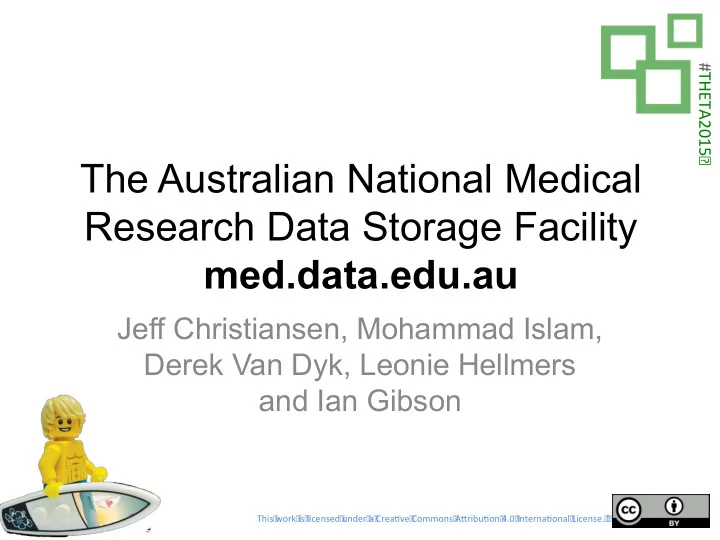

#THETA2015� The Australian National Medical Research Data Storage Facility med.data.edu.au Jeff Christiansen, Mohammad Islam, Derek Van Dyk, Leonie Hellmers and Ian Gibson This� work� is� licensed� under� a� Crea ve� Commons� A ribu on� 4.0� Interna onal� License.� �
med.data.edu.au • What is it? • What are the drivers? • Where did it come from? • Who has signed up? • Data Types • Why does it matter? • What will it do and how will it work? • What’s its status?
What is it?
What is it? • a National Facility to provide: • Highly secure petabyte-scale data storage • Related high-speed networked and secure computational services for Australian medical and health research organisations
What are the drivers?
What are the drivers? 1. Strategic reviews have pointed to an increased requirement to consolidate , aggregate and collaborate to maximise research outcomes www.mckeonreview.org.au/
What are the drivers? www.mckeonreview.org.au/
What are the drivers? www.mckeonreview.org.au/
What are the drivers? www.mckeonreview.org.au/
What are the drivers? 2. Fast growth of the volume of medical research data
What are the drivers? 2. Fast growth of the volume of medical research data – e.g. imaging Jeff Lichtman/Harvard University, CC BY-NC-ND Dan Vogel, CC BY-2.0
What are the drivers? 2. Fast growth of the volume of medical research data – e.g. genomic Guy Cochrane, EBI
What are the drivers? 2. Fast growth of the volume of medical research data Illumina HiSeq X TEN ~USD 1000 per genome 0.6 terabases of sequence per day 3-4 terabytes of data per day 10 machines @ the Kinghorn Centre for Clinical Genomics (Garvan Institute) www.businesswire.com
What are the drivers? 3. The rise of personalised medicine
What are the drivers? 3. The rise of personalised medicine CLINICAL RESEARCH and DATA ADMINISTRATIVE RECORDS UNIVERSITY
Where did it come from?
Where did it come from? • Funded through RDSI , RDS and ANDS projects • All part of the NCRIS program • Over $1 billion over past few years • $150M planned for 2015-16 • Longer term planning underway
Where did it come from? • RDSI: established 8 large data storage facilities nationally
Where did it come from? • RDSI: established 8 large data storage facilities nationally • Intended to store research data of value for future research • Total storage ~50 petabytes • Large Collections Program • Medical, Imaging, Astronomy, Ecology, Genomics
Where did it come from? • RDS: making RDSI storage sustainable.
Where did it come from? • RDS: making RDSI storage sustainable. • optimising and maturing the RDSI capability for 9 data-intensive research communities: Medical, Climate, Genomics, Humanities, Astronomy, Ecology, Marine, Geoscience, Imaging . • integrate rapidly expanding data holdings with the cloud and supercomputing infrastructure to provide a truly high-performance data using capability
Where did it come from? RDSI/RDS Medical
Where did it come from? • ANDS: ensuring research data is: • Managed • Connected • Findable • Reusable
Where did it come from? • ANDS: ensuring research data is: • Managed • Connected • Findable • Reusable • Data Management for all users of RDSI • Incl. independent Medical Research Institutes
Who has signed up?
Who has signed up? • 31 letters of support including 20 Medical Research Institutes
Who has signed up? Melbourne Brain Centre Imaging Unit Melbourne femur collection Health and Biomedical Informatics Centre The Nold Laboratory Rapid Autopsy in Melanoma Consortium 53 organisations Melbourne Genomics Health Alliance
Data types • Imaging • MRI, CT, PET, Xray , histology… • Clinical • Surveys, pathology, video assessments, patient data, longitudinal studies, clinical trials, eHealth, EEG, anatomy/morphology, personalised medicine, drug discovery/therapeutics… • “ Omics ” • Genomics, Transcriptomics , Proteomics… • Biobanking • Computational modelling • Health economics
Why does it matter?
Why does it matter? • Compliance and data security/privacy • Efficiency and cost effectiveness • Supporting translational impact • Enabling new research methods and outcomes
What will it do?
What will it do? • Store data – securely, including identifiable data • Describe data – at collection and item level • Find data – at collection level • Share data – under appropriate conditions • Use data – via a number of associated tools (TBD) – including secure options
What will it do? • Store data – securely, including identifiable (sensitive) data • Describe data – at collection and item level • Share data – only under appropriate conditions • Find data – at collection level • Use data – via a number of associated tools (TBD) – to include highly secure options
How will it work?
How will it work? • Each node is an independent entity • Storage + (HPC, Cloud) • Connected via AARNet • Data custodian enters into data storage agreement with node of their choice – typically the local one • Data custodians retain control over access
How will it work? • Governance: Advisory Board (current)
What’s its status?
What’s its status? • Project team established • Advisory Board established
What’s its status? Melbourne Brain Centre Imaging Unit Melbourne femur collection Health and Biomedical Informatics Centre The Nold Laboratory Rapid Autopsy in Melanoma Consortium Melbourne Genomics Health Alliance
What’s its status? • 80 foundation data collections identified • 4 PB • 80 technical analyses underway • 53 organisations across 4 states • Security • Access control • Use cases
What happens next?
What happens next? • Signing up more organisations • Establish roadmap of services – data, metadata standards, data management and curation, APIs, analytics
What happens next? • Signing up more organisations • Establish roadmap of services – data, metadata standards, data management and curation, APIs, analytics • Opportunity to align access methods across consenting collections • Conducting research across aggregated collections
Thanks
med.data.edu.au Supported by:
Recommend
More recommend